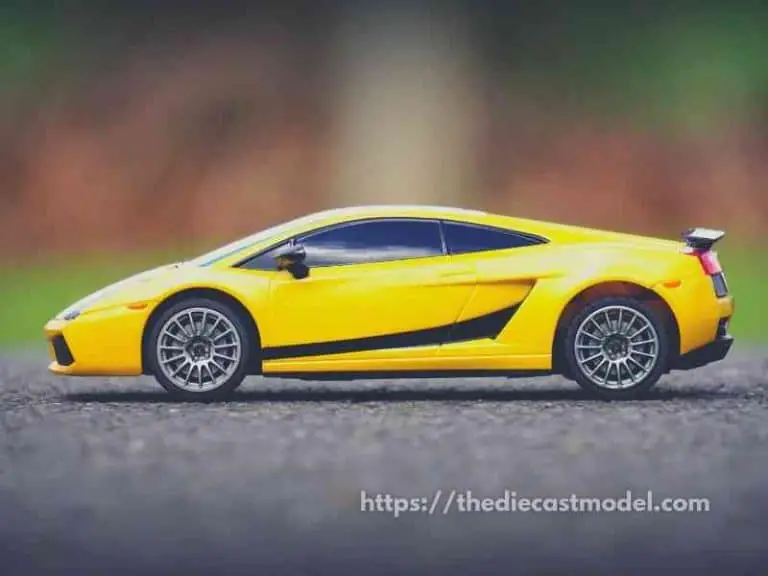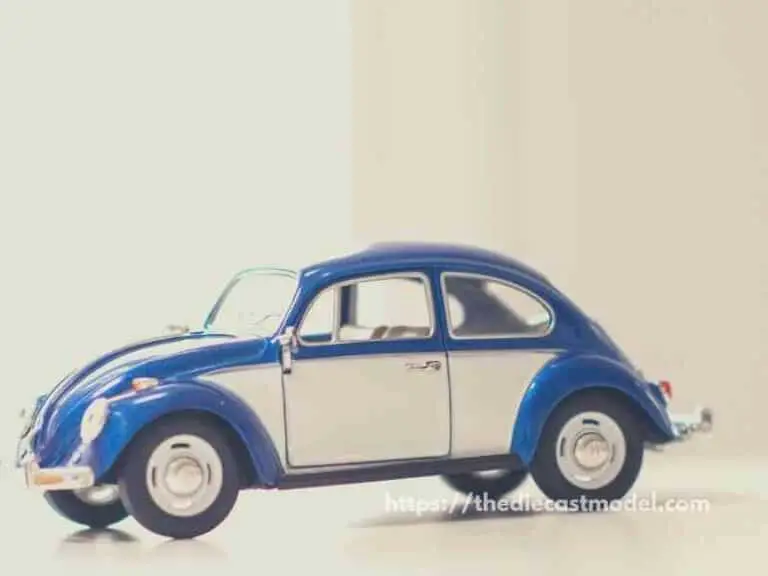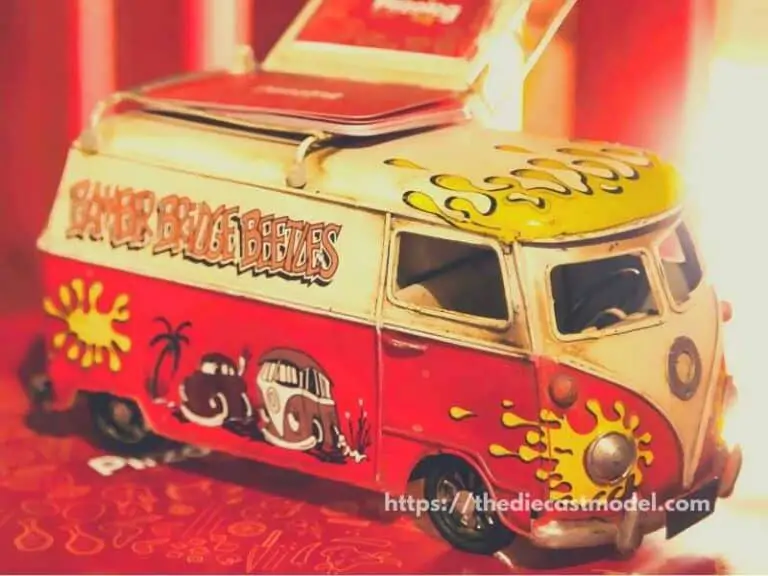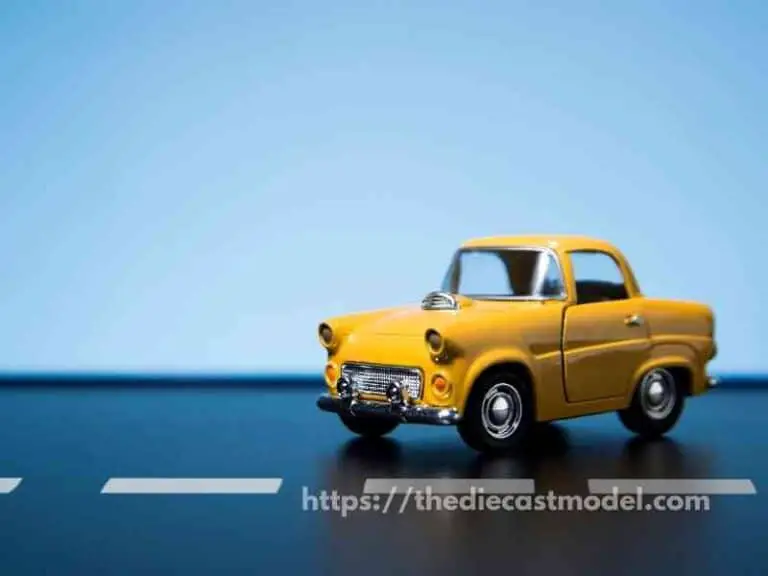Diecast Models: Everything You Need To Know (Brands, Scales, Worth, Customs, Buying, Selling)
Not only am I a fan and collector of diecast models, but I have also written more than 100 articles related to diecast models. Thus, I can nearly say that I am now qualified to make a comprehensive post of everything you need to know about diecast models.
Diecast models are replicas made using the diecasting technique. The diecasting technique is a method used to put molten metal alloys into a mold. This is a cost-efficient way of producing models, and at the same time, they can be mass-produced for a low price.
This article will consist of everything I know and can think of about a diecast model that a person might ask. This includes diecast models, their metal used, the diecasting process, types of diecast, brands, worth of model cars, diecast scales, and their marketplace.
If you’re a beginner and starting to collect models, this is the article for you. You’ll know everything about the hobby of collecting models. From the diecasting process to where you can buy and sell your collection.
This can serve as a simple guide for you to renew or learn about the newer things about the hobby for seasoned collectors. This can include introducing resin diecasting techniques and even the marketplaces where you can sell your precious collection.
For diecast investors, this article can also help since I would also cover value and what affects the value of model cars. Finally, we would talk about investing in diecasts and some easy things to do to maintain or even increase the price of your collection.

What is a Diecast Model?
A diecast model is a replica created using the diecasting process. Basically, diecasting is a process of turning metal alloys into various shapes using a mold called the die. Casting is the process of pouring metal alloys into molds that are cooled down to form solid and complicated shapes.
Later on, we will talk about the process of diecasting. But for now, let’s talk about what exactly is a diecast model.
A diecast model is any replica that is made using the diecasting process.
Metal replicas of cars, helicopters, tanks, trucks, motorcycles, and more are called diecasts.
However, not all replicas are diecast. For example, there are also plastic models such as Tamiya, Airfix, and more.
Furthermore, there are also wood models which aren’t also diecast.
When we talk about diecast, we are talking about models that use a specific metal alloy called Zamak.
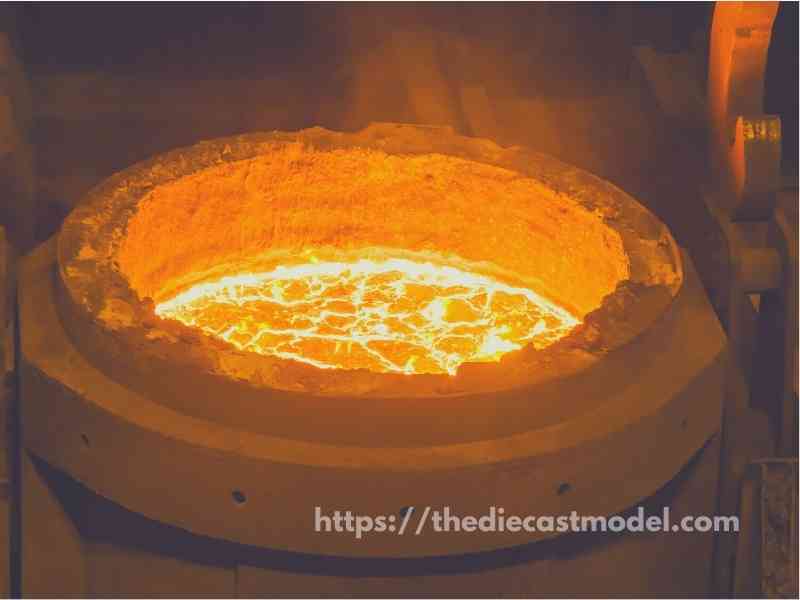
What metal is used in diecast cars?
The metal used in diecast is called Zamak. Zamak is a metal alloy that uses a combination of metals such as aluminum, magnesium, zinc, and lead. Zamak is used in the diecasting process because it offers a cheap way to produce sturdy and detailed models.
It isn’t true that all metal replicas are diecast. For example, models that are made of iron aren’t diecast.
Diecast models or cars are made using Zamak, which is a combination of aluminum, magnesium, zinc, and lead.
This means diecast models don’t contain iron. That is also why these models don’t rust. Instead, they form zinc pests, a greenish-white discoloration that happens when diecast metals are oxidized.
For more information about Zinc Pests and why diecast models don’t rust, feel free to check this post: Do diecast models rust? How to prevent diecast rust?
The point here is not all metal replicas are diecast models. Instead, diecast models use a metal alloy called Zamak.
A common question I get from emails is why diecast models use metal alloys instead of pure metals.
Metal alloys are made to counteract the disadvantages of pure metals.
For example, while aluminum is recyclable, it is soft. That’s why adding other metals to the mixture can strengthen the model.
Another example is zinc. While zinc is a strong metal, it corrodes into zinc pests, and to slow down the process, they add magnesium and aluminum into the mixture.
Alloys allow the construction of cheaper and sturdier forms of metals.
For example, iron alone is not as strong. However, if you combine iron and carbon, then you produce steel.
Did you know that diecast metals are very recyclable and can use recycled materials? In fact, almost 95% of the aluminum used in the diecasting process is recycled. To know more about the environmental impacts of diecasting, feel free to check this post: Can you recycle diecast?
What is the Diecasting Process
The diecasting process is a procedure that turns molten metal alloys into complex shapes. Putting metal alloys into molds is called the casting, and die is the mold used in the process.
Simply put, diecasting is a process of pouring molten metal into molds which are called a die. The entire process is called casting. Combining these, you have diecasting.
However, there are many ways of producing diecasts, and the process can vary.
For example, the cooling process can be rapid or non-rapid cooling.
Rapid cooling allows faster production but lessens the durability of the finished product. Non-rapid cooling, on the other hand, produces sturdier models.
Another difference is how they put molten metal into the molds. The traditional way of putting molten metal into molds is by pouring, using gravity to fill the molds.
However, they found that injection molding helps produce denser and sturdier models.
The disadvantage of injection molding is that it requires complex equipment as the machine should inject molten metals, which can be as hot as 1,250°F or 678°C.
If you want to learn more about the whole diecasting process, please check this post: How are diecast models made? (9 steps).
Types of Diecasts
The two types of diecast models are the Zamak or zinc diecast and the Resin diecast. The difference between the two is that Zamak diecast is made using metal alloys while Resin diecast is made using resin polymers.
Many people see diecast models as the models that are made of Zamak. However, there is a newer type of diecast model known as the resin model.
Resin models are made using resin polymers.
Resin models are relatively new to the market, and some model brands are only adopting resin models because it is becoming popular with collectors.
The main reason resin models are becoming popular is that they allow more complex shapes and curves than traditional zinc diecasts.
Some early adopters of the Resin diecasts are AUTOArt and Spark models.
However, some modelers still prefer the traditional zinc diecast since they are generally sturdier than resin diecast.
Here is a table summary of the differences between zinc and resin diecast:
| Resin Models | Diecast Models |
| Can make smaller parts | Can’t make smaller parts |
| Less Durable | More durable |
| Highly Detailed | Less Detailed |
| No Zinc Pest | With Zinc Pest |
| Ideal for Smaller Models | Ideal for Larger Models |
| Silicone Mold | Metal Mold |
For more information regarding the differences between zinc and resin diecast, feel free to check my other post here: Zinc vs. Resin Diecast.
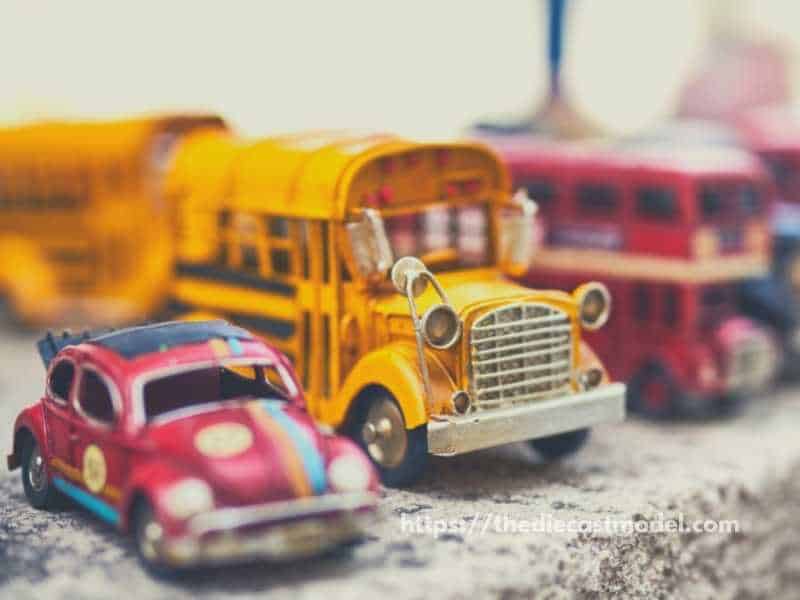
What is the best diecast brand?
The best diecast model brand is AUTOart because of its strict attention to detail. Furthermore, it is loved by many modelers since 36.5% of modelers think that AUTOart is the best diecast brand.
The best diecast brand is subjective and depends on the person.
For example, if a collector is looking for variety and price, then Hot Wheels can be considered the best.
For people looking for details, AUTOart has been delivering quality models for a long time.
If you’re a Nascar diecast lover, then Elite diecast is for you.
If you’re into cars from movie franchises such as fast and furious cars, then Jada is the best.
When I was researching this topic when I wrote the post, I was confused. That’s why I got the idea of surveying people into diecast models.
Here is the summary of the survey conducted.
| Model Brand | Percent Vote |
| Matchbox | 7.30% |
| Hot Wheels | 35.04% |
| AutoArt | 36.50% |
| Minichamps | 8.03% |
| Maisto | 5.84% |
| Bburago | 7.30% |
If you want to know how I made the survey, feel free to check this post: WHich diecast car brand is the best? A Survey from a community of 24,300 collectors.
When I looked in the data, we have AUTOart as the best, having 36.5% of votes, while Hot Wheels got second place with 35.04% of the votes.
The Worth of Each Diecast Cars
The worth of diecast models depends on numerous factors such as their rarity, age, condition, and more. Rare diecast models can go for thousands of dollars such as the 1969 Volkswagen Beach Bomb which has a value of $150,000.
Many rare diecast models go for thousands of dollars.
The 1969 Volkswagen beach bomb is quite rare and old, so it was valued at $150,000.
What’s more, is the beach bomb is from Hot Wheels.
For more examples of expensive 1960s Hot Wheels, please check this post: How much are 1960s Hot Wheels?
Another expensive Hot Wheels is the Classic 31′ For Woody, valued at around $5,200.
Models don’t need to be that old to be expensive or worth it. For example, the 1995 Hot Wheels treasure hunt set has a value of $3,600.
For more examples of expensive 1990s Hot Wheels, feel free to check this post: Are 90s Hot Wheels Worth it?
These prices aren’t only for Hot Wheels. Other brands can have high costs such as these.
For example, the 1907 Franklin Mint Connoisseur’s edition was sold in an auction for $2,000.
Another example is the 1984 #7 Nascar Wrangler Old Omega sold at $1,650.
For Corgi toys, the 9022 Daimler 38HP Model has a value of $4,535.
For Dinky toys, the 1961 France Jouet Fj Berliet Tractor was sold in an auction for $2,115.
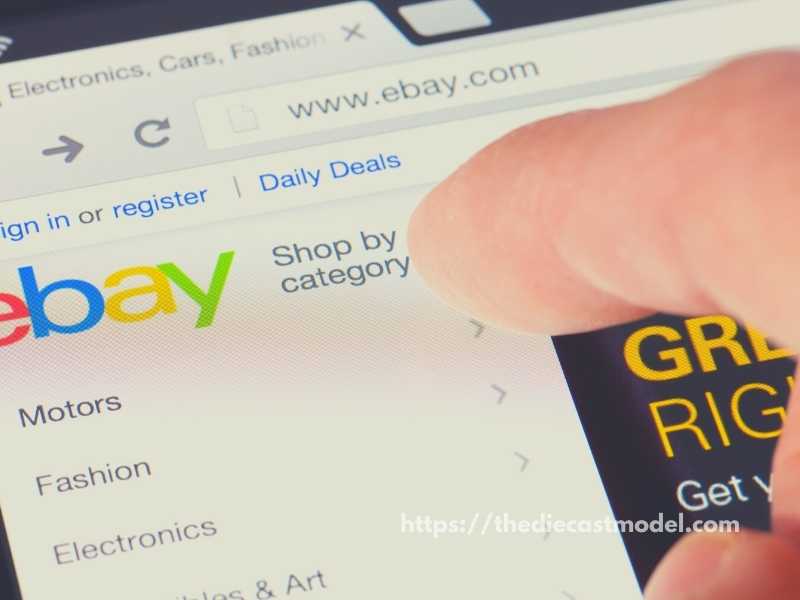
Do diecast cars increase in value?
Diecast cars increase in value and are a good investment. Many diecast models are in limited edition especially many models that specify their year of production. Over time, these old models tend to be rare and thus, cost more money.
The advantage of diecast models is that they are easy to maintain and don’t rust.
That’s why diecast cars produced in the early 1900s are still around today and now cost thousands of dollars.
Since these models are becoming rare and are easy to maintain, they are perfect collectibles.
It is essential to collect diecast models to know their year of production to know their worth.
Different brands have their own rules in indicating the year of production. So, for example, I made a guide on how to tell how old a Hot Wheel is.
Usually, the year of production is indicated when selling the models. That’s why some of my examples above indicated their year of production.
Do Diecast cars decrease in Value when out of the box or package?
Generally speaking, diecast cars decrease 20-25% in value when out of the box. This is because collectors have always preferred mint-in-condition.
Mint-in-condition models signify that the model has been carefully taken care of by the previous owner.
That’s why collectors have always preferred mint-in-condition. Thus, they cost more.
How I got on the 20-25% decrease in value came from my experience and computing how much a model would be sold if inside or outside the box.
If you want to read a detailed blog post on the topic, please check this post: Value of models inside vs. outside the package.
What are the Scales used in diecast models?
Many scales are used in diecast models, but the popular ones are 1:12, 1:18, 1:24, 1:32, 1:43, and 1:64 scale. Furthermore, other scales depend on the type of model. For example, airplane models have 1:72, 1:200, and 1:500 scales.
Many diecast scales depend on the type of model.
This is because a scale is the relative size of the model compared to the actual object.
For example, a 1:18 scale model is 1/18th the size of the real object.
That’s why a 1:18 scale model can be used for cars since a 1/18th size of a car can still be easily stored as a model.
However, a 1:18 scale airplane model isn’t easy to store since planes are way bigger than cars.
While there are 1:18 scale airplane models, they aren’t as common as a 1:72 scale.
Furthermore, scales don’t always come with 1 as their numerator. For example, there is a 7/8th scale collector airplane model of the Pitts Python Biplane.
When it comes to the sizes of these scale models, it depends on the size of the real object.
However, I have estimated how big are each scale.
| Diecast Scale | Approximate Size |
|---|---|
| 1/12 Scale | 14-15 inches / 36-38cm |
| 1/18 Scale | 9-12 inches / 24-30 cm |
| 1/24 scale | 6.5-8 inches / 16-20 cm |
| 1/32 Scale | 4-6 inches / 10-15 cm |
| 1/43 Scale | 3.5-5 inches / 8-12 cm |
| 1/64 Scale | 2.5-3 inches / 6-7.5 cm |
For more information regarding this table, you may check this post: Average Size of Diecast Scales
Can you design your own diecast models?
You can design your own diecast models by using paints, brushes, and sandpaper. In painting, you can opt for spray painting, enamel, or acrylic paints and apply them using an airbrush, regular brush, or spray paints.
However, you can’t produce your models from scratch since diecasting requires complicated metals.
Some people make their models by 3D printing. However, the resulting model is not a diecast model. Instead, it produces a plastic model.
But many modelers love designing their own model with their preferred color. Some even restore old models by removing the old paint and then painting them to look brand new.
In fact, some modelers earn money by buying old broken models then restoring them to look brand new.
Diecasting hobby is wide. Some prefer collecting in mint condition, while some prefer opening their models and redesigning them.
Whatever route you decide depends on you, but I suggest designing your models as it is fun and exciting.
Contrary to most think, you don’t need to buy expensive tools to design your own models. You can also practice with cheap diecast models.
You can start designing your own models with spray paint as I did in the past. From there, you can upgrade to brushes and airbrushes.
Spray paint is a cheap alternative to model painting, and with proper guidance, you can also produce high-quality results.
If you need a guide on using spray paint on models, here is a post I made regarding the topic: Can you use spray paint on models?

Where can you Buy and Sell Diecast Models?
You can buy and sell diecast models on different online and offline marketplaces such as eBay, QDT, Facebook marketplace, conventions, Pawnshops, and car booth sales.
If you have any models in your basement that you want to sell, there are many places where you can sell them both offline and online.
For example, eBay is popular when it comes to selling these collectibles.
If you want a quick buck, you can try selling in pawnshops.
However, I recommend studying the marketplace where you want to sell your models.
For example, it is good to make sure that the certificate of authenticity is legit. Furthermore, make sure that the ones being sold are really the item being sold.
Some people write their name on a paper, put the paper together with the model, and take a photo. This makes sure that the image isn’t taken elsewhere and the person genuinely has the model.
Furthermore, there are registrations and bonuses each of these marketplaces offers to new buyers or sellers.
I made a complete guide on where to sell these models and how you can maximize profits when selling them. You can check the guide here: A helpful guide on buying and selling models.
Conclusion
I can’t believe I wrote all of these in 1 sitting.
This blog post tells every essential thing you need to know about diecast models.
As you can see, this post is filled with links that point to other posts that deeply talk about the specific topic. So feel free to read on what interests you the most.
This is because deeply explaining everything can turn this post into more than 10,000 words which I don’t think anyone will read through to the end.
I hope this post helped you get the basics of diecast models.

“Only the things I love”
thediecastmodel.com is reader-supported. When you buy through links on the site, I earn an affiliate commission.
So, here are the things I love when taking care of my Diecast Models.
Cleaning the Models
The first we are going to talk about is cleaning the models.
Removing Dust
- Air Brush – For me, this is the best since it not just removes dust but you can use it in painting/clear coating.
- Air Duster – This is a good alternative to Airbrush
- Normal Brush – If you are short on budget, you can use a normal brush. However, make sure that the brush has soft bristles because there are some hard brushes than can cause scratches. That’s why I recommended a good brush that can do the job properly.
Cleaning and Shining Hacks
Well, here are some of my cleaning hacks for removing scratches, oxidation, and so much more.
- Removing Decal Adhesive – Use Goo Gone on those hard-to-remove decal adhesives. It works fast and works like charm!
- Waxing and Polishing – Here is something a lot of people don’t know. Waxing protects the clear coat and paint while polishing shines the model. Instead of buying it separately, use a 2 in 1 to save money. Get this instead.
- Beginner Wax – The wax I recommended earlier is good and provides the best results based on my experience. But a beginner might have a problem especially if they’re not good at applying wax. Solid wax reaching hard to reach surface can be hard to remove. You have two choices here. One is to use a qtips to reach those surfaces, another is to use a liquid wax I recommended.
- Cleaning Wheels, Rubber, Plastic – Do not forget that rubber and plastic surface are quite different, especially in the cleaning process. Just wiping it down won’t do the job. That’s why I use Meguiar’s Vinyl and Rubber Cleaner and Conditioner. Works like charm!
- Make the Wheels Shine! – Making our models look good won’t be complete without tiny details such as shiny wheels! Do not forget this because however small this is, the difference can be as big as night and day.
- Remove Scratches Easily – Tiny scratches are not the end for your model. Here is a simple trick I’ve been using to make my models look scratch-free even without repainting. Use T-Cut.
Painting the Models
Painting Tools
Make sure when you paint models, have these ready.
- Tape – A tape is important if you are painting a straight line. Furthermore, it will prevent your paint to scatter on other parts. I recommend Tamiya Tape since it is really made for models. Furthermore, they stick really well preventing paint splatters.
- Brush (Beginner) – Find a good set of brushes to paint your models. Of course, you can opt for an airbrush but it’s quite expensive.
- Airbrush (Intermediate/Expert) – This will yield a significantly better result than an ordinary brush because you can easily spray the paint evenly. I recommend this if you know what you’re doing.
- Stand(Optional) – Stands are good because it can be hard to manually hold the models while painting. It is optional but in my opinion, the price is well worth it for the comfort it gives.
- Drop Cloths – Drop Cloths will protect your surroundings from the paint.
- Primer – The most common beginner mistake I see is painting models without any Primer. A primer will prevent imperfections such as bubbles or paint not sticking to your models. It is a small price to pay for quality results.
- Clear Coat – A clear coat will protect the paint of your models. This will make the paint last longer. Also, it is the one responsible for making your models shine.
Paints
Of course, you can’t do painting properly without paint. So here are the ones I recommend.
- Acrylic Paint – Good for beginners because it dries quickly. However, it doesn’t produce results as good as enamel paint.
- Enamel Paint – Provides a good quality finish and longer-lasting paint. However, it takes longer to dry and requires expertise to use.
Model Maintenance
Model Storage
- Simple Wood Cabinet – While it doesn’t let you display your models, wooden cabinets are good storage for these models. For one, they are not heat conductors which means that the temperature inside will remain constant and remain cool. Furthermore, they prevent light from reaching the models which can cause oxidation.
- Clear Cabinet with Lock – If you want to display your models, then I recommend this. It closes so dust won’t easily get to your models. I also recommend you don’t put more than 1 model in each compartment since metals are good conductors of heat.
Model Photography
So you want to show off your models to others? Well, I got you covered.
Here is my beginner-friendly model photography tutorial that teaches everything from taking pictures to the editing process.
You will also see me doing hands-on photography in that tutorial.
Here is the link: How to Take Pictures of a Diecast Model or Model Kit | Helpful Illustrated and Video Guide

